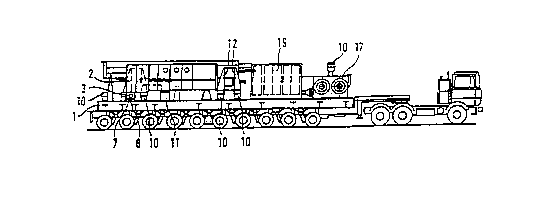Some of the information on this Web page has been provided by external sources. The Government of Canada is not responsible for the accuracy, reliability or currency of the information supplied by external sources. Users wishing to rely upon this information should consult directly with the source of the information. Content provided by external sources is not subject to official languages, privacy and accessibility requirements.
Any discrepancies in the text and image of the Claims and Abstract are due to differing posting times. Text of the Claims and Abstract are posted:
| (12) Patent Application: | (11) CA 2260979 |
|---|---|
| (54) English Title: | ARRANGEMENT OF A SCRAP CUTTER FOR THE TRANSPORTATION, ASSEMBLY AND DISMANTLING THEREOF, AND METHOD OF ASSEMBLING SAID ARRANGEMENT |
| (54) French Title: | AGENCEMENT D'UNE CISAILLE A RIBLONS PERMETTANT DE LA TRANSPORTER, DE LA MONTER ET DE LA DEMONTER ET PROCEDE DE REALISATION DE CET AGENCEMENT |
| Status: | Withdrawn |
| (51) International Patent Classification (IPC): |
|
|---|---|
| (72) Inventors : |
|
| (73) Owners : |
|
| (71) Applicants : |
|
| (74) Agent: | GOWLING WLG (CANADA) LLP |
| (74) Associate agent: | |
| (45) Issued: | |
| (86) PCT Filing Date: | 1997-01-17 |
| (87) Open to Public Inspection: | 1997-07-24 |
| Examination requested: | 1999-01-13 |
| Availability of licence: | N/A |
| Dedicated to the Public: | N/A |
| (25) Language of filing: | English |
| Patent Cooperation Treaty (PCT): | Yes |
|---|---|
| (86) PCT Filing Number: | PCT/DE1997/000077 |
| (87) International Publication Number: | DE1997000077 |
| (85) National Entry: | 1999-01-13 |
| (30) Application Priority Data: | ||||||
|---|---|---|---|---|---|---|
|
In order to reduce assembly and dismantling times whilst retaining the
properties of mass-produced components, the invention proposes a scrap cutter
transport unit with a base frame (1) for accommodating assemblies both in
their transportation and their operating states. During transportation, the
transport unit accommodates the cutter stand (2) in the removed state so that
it can pivot about a point (3). A second transport unit is formed by the press
frame which comprises auxiliary supports for transportation purposes.
L'invention concerne une cisaille à riblons pour laquelle, afin de parvenir à des temps de montage et de démontage plus courts, sans altérer les propriétés d'éléments constitutifs produits en série, il est prévu de réaliser une unité de transport avec un cadre de base (1) destiné à recevoir des sous-groupes, que ce soit à l'état prêt au travail ou à l'état prêt au fonctionnement. Pendant le transport, cette unité de transport reçoit le support (2) de cisaille à l'état déposé, afin qu'il puisse pivoter autour d'un point d'appui (3). Une autre unité de transport formée par le bâti de presse présente des supports auxiliaires pour le bâti port.
Note: Claims are shown in the official language in which they were submitted.
Note: Descriptions are shown in the official language in which they were submitted.

2024-08-01:As part of the Next Generation Patents (NGP) transition, the Canadian Patents Database (CPD) now contains a more detailed Event History, which replicates the Event Log of our new back-office solution.
Please note that "Inactive:" events refers to events no longer in use in our new back-office solution.
For a clearer understanding of the status of the application/patent presented on this page, the site Disclaimer , as well as the definitions for Patent , Event History , Maintenance Fee and Payment History should be consulted.
| Description | Date |
|---|---|
| Inactive: IPC from MCD | 2006-03-12 |
| Inactive: Office letter | 2001-03-19 |
| Inactive: Withdraw application | 2001-03-08 |
| Inactive: Withdraw application | 2001-03-08 |
| Inactive: Approved for allowance (AFA) | 2001-01-18 |
| Deemed Abandoned - Failure to Respond to Maintenance Fee Notice | 2001-01-17 |
| Inactive: Entity size changed | 2000-02-09 |
| Inactive: Correspondence - Formalities | 2000-01-28 |
| Inactive: Office letter | 2000-01-17 |
| Inactive: First IPC assigned | 1999-03-23 |
| Inactive: IPC assigned | 1999-03-23 |
| Inactive: IPC assigned | 1999-03-23 |
| Classification Modified | 1999-03-23 |
| Inactive: Acknowledgment of national entry - RFE | 1999-03-10 |
| Application Received - PCT | 1999-03-05 |
| All Requirements for Examination Determined Compliant | 1999-01-13 |
| Request for Examination Requirements Determined Compliant | 1999-01-13 |
| Application Published (Open to Public Inspection) | 1997-07-24 |
| Abandonment Date | Reason | Reinstatement Date |
|---|---|---|
| 2001-01-17 |
The last payment was received on 1999-12-23
Note : If the full payment has not been received on or before the date indicated, a further fee may be required which may be one of the following
Patent fees are adjusted on the 1st of January every year. The amounts above are the current amounts if received by December 31 of the current year.
Please refer to the CIPO
Patent Fees
web page to see all current fee amounts.
| Fee Type | Anniversary Year | Due Date | Paid Date |
|---|---|---|---|
| Basic national fee - standard | 1999-01-13 | ||
| Registration of a document | 1999-01-13 | ||
| MF (application, 2nd anniv.) - standard | 02 | 1999-01-18 | 1999-01-13 |
| Reinstatement (national entry) | 1999-01-13 | ||
| Request for examination - standard | 1999-01-13 | ||
| MF (application, 3rd anniv.) - small | 03 | 2000-01-17 | 1999-12-23 |
Note: Records showing the ownership history in alphabetical order.
| Current Owners on Record |
|---|
| SVEDALA LINDEMANN GMBH |
| Past Owners on Record |
|---|
| HEINRICH KNUFMANN |
| MICHAEL SCHAAF |
| PETER POHL |